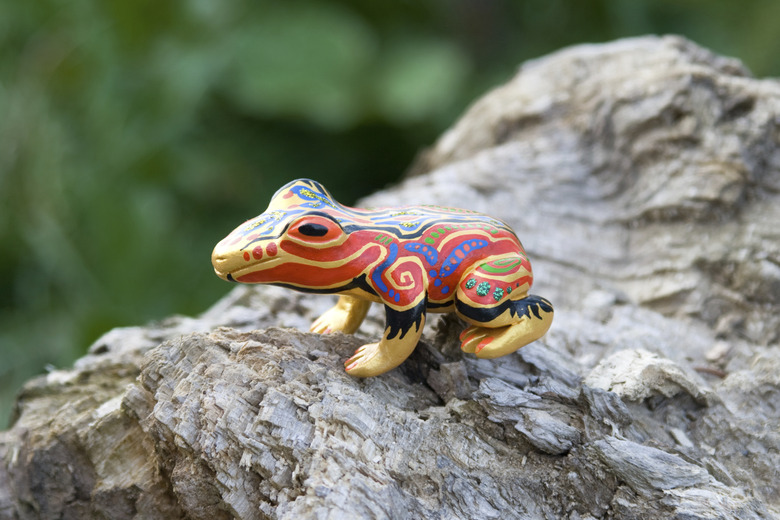Activities To Go With Tiddalik The Frog
"Tiddalik: The Frog Who Caused a Flood" is an Australian aboriginal folk tale that tells the story of a giant, grumpy frog that consumed all the world's water to quench his thirst. The land turned to desert and animals worried for their lives. They thought if they could make Tiddalik laugh, the water he consumed would spill out, so they took turns trying to make the frog laugh. Teach children the Tiddalik story in conjunction with assorted activities to reinforce the material.
"Make Tiddalik Laugh" Coloring Sheets
"Make Tiddalik Laugh" Coloring Sheets
Give each child a sheet of paper that features a large drawing of a frog with a blank space on the frog's insides for making drawings. Children can each draw something within the blank space that they think will make Tiddalik laugh, such as standing on their heads, making funny faces and performing silly dances. Look for worksheets that feature the Tiddalik design through online education sites or by drawing your own version.
Dioramas
Dioramas
Children can enjoy creating dioramas based on the Tiddalick story, such as images of Tiddalik drinking all the world's water or assorted animals trying to make Tiddalik laugh. Reuse shoe boxes for the diaromas. Use polymer clay or card stock to make assorted animal images, and use shades of orange and tan paint or crayons to create an outback setting. If creating the animals out of card stock, bend back about 1/2 inch of the bottom of the paper to create standing pieces.
Puppets
Puppets
Help children tell the Tiddalik story by supplying them with materials to make Tiddalik puppets. Cut card stock into the various animal shapes, including Tiddalik, Bandicoot the Kangaroo and Nabunum the Eel. Have the children decorate the animals using markers, paint, or crayons, and attach tongue depressors to the backs of the card stock as puppet handles. Put on a play using the puppets, or have each child come up to the front of the room with their puppet at the animal's mention when the story is being told.
Sound Activities
Sound Activities
Use an educational website that features the various sounds featured in the Tiddalik story, such as the sound of gushing water, Tiddalik gulping and burping, assorted animal sounds, and weather effects. You can also look for such sound effects on other sound effect websites, many of which have free sounds for downloading. Have the children take turns guessing what the sound they are hearing is as you read the story aloud.
References
Cite This Article
MLA
McGroarty, Kent Page. "Activities To Go With Tiddalik The Frog" sciencing.com, https://www.sciencing.com/activities-tiddalik-frog-12184765/. 24 April 2017.
APA
McGroarty, Kent Page. (2017, April 24). Activities To Go With Tiddalik The Frog. sciencing.com. Retrieved from https://www.sciencing.com/activities-tiddalik-frog-12184765/
Chicago
McGroarty, Kent Page. Activities To Go With Tiddalik The Frog last modified March 24, 2022. https://www.sciencing.com/activities-tiddalik-frog-12184765/
